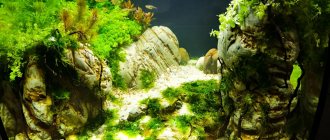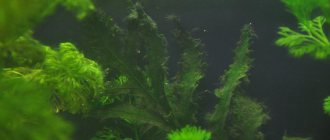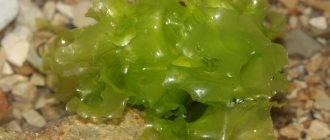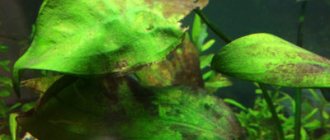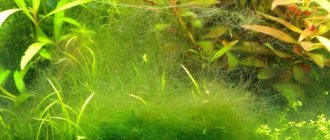Owners of suburban areas who are lucky enough to have a small artificial fish pond in their yard know how difficult it is to clean the tank. Therefore, it is recommended to carefully consider and balance the number of fish species so that with their help the pond is at least partially self-cleaning. Harmony in an artificial reservoir allows for less frequent cleaning and improves the appearance and health of its inhabitants. To make it easier to understand this issue, we present a list of fish that feel most comfortable in our climate, as well as their main characteristics:
White amur
They clean the pond well of various plants, feeding on them. He doesn't care what kind of grass he is fed. Even if you throw lawn grass into the pond, he will eat it with pleasure. They can grow up to 50 kg, and jump above the surface of the water to a height of 1 m. They can be grown in artificial reservoirs.
Read more information about grass carp fish in the article
Ancistrus
This is the most popular and widespread fish among all algae eaters. Quite unpretentious, they also look interesting, especially the males, who have luxurious growths growing on their heads. However, ancistrus are quite large fish and can reach 15 cm or more.
They need a large amount of plant food, they additionally need to be fed with catfish tablets and vegetables, for example, cucumbers or zucchini. If there is not enough food, they can eat young shoots of plants. Peaceful towards other fish, they are aggressive towards each other, especially males and protect their territory.
Decorative crucian carp
Perfect for a shallow reservoir, but only if there is no need to spend the winter. Individuals have an attractive appearance, their body is covered with golden scales that shimmer in the sunlight. The character is usually calm, the fish quickly get used to people and can even be taught to feed from your hand.
Siamese algae eater
The Siamese algae eater, or as it is also called SAE, is an unpretentious fish that grows up to 14 cm in length. In addition to eating algae, CAE also eats tablets, live and frozen food. Like Ancistrus, Siamese are territorial and protect their territory. A special feature of SAE is that they eat Vietnamese and blackbeard, which are not touched by other fish and invertebrates.
Eliminating unwanted algae in an aquarium
ARTICLES December 16, 2021
| Killing algae in an aquarium is not easy. In fact, the main thing is to prevent algae from growing. And here algae-eating fish will be of great help to the aquarist. |
Destruction of algae in an aquarium is an eternal topic! Aquarium forums on the Internet are literally inundated with questions about how to eliminate this scourge. For beginners, let me remind you that not all aquarium vegetation is correctly called algae. Cabombas, rotals, ludwigias, echinodorus, cryptocorynes and other aquatic plants that can often be seen in aquariums are all higher plants. And the term “algae” is applicable only to the lower ones. They usually take the form of unsightly green or brown deposits, fringes, tassels, tufts of dark or light threads on the walls of the aquarium, stones, soil and the aquarium plants themselves. Thus, it is incorrect to call the flora that we plant in an aquarium and specially grow in it algae. Aquarium plants are not algae! They belong to flowering plants, ferns and mosses. They are the ones who decorate the aquarium, while lower plants, that is, algae, usually only spoil the appearance of the aquarium. Therefore, an aquarist, unless he doesn’t care what his aquarium looks like, has to wage a protracted war with algae. But it is very difficult to destroy algae!
Long threads of green algae. Perhaps the most effective way to deal with them is to wrap them around a wooden stick and throw them away. In a sense, this is also a biological method of control.
Algae end up in the aquarium as uninvited guests. Alas, these “guests” are sure to come. It is almost impossible to isolate yourself from them with an iron curtain of quarantines and sanitary treatments of fish, plants, soil, and aquarium equipment.
| Left: a leaf of spiral vallisneria is infected with “flip-flop” ( Audouinella ), a red algae that some aquarists spend a lot of effort and money on fighting, but still cannot win. Others simply refuse higher plants, and get so used to the algae growing on stones and other elements of the aquarium design that they begin to perceive them as quite nice vegetation. Right: slimy dark green films with a characteristic odor can quickly begin to cover the soil and leaves of plants - these are blue-green “algae” (cyanobacteria). Neither fish, nor shrimp, nor snails eat them. You can fight blue-greens only with the help of chemical and physical methods. For example, using hydrogen peroxide and Virkon-S to destroy them is quite possible |
Sometimes an algae invasion begins to take on the appearance of a real natural disaster. Plant leaves, aquarium glass and soil can quickly become covered with slimy brown or dark green films with a bluish tint. This happens mainly among inexperienced hobbyists who have not yet learned how to maintain biological balance in their aquarium, as well as when the aquarium is started incorrectly or in “old” aquariums that have no longer been properly cared for. A well-balanced aquarium creates conditions unfavorable for the development of algae, in which they will behave very modestly and are not at all conspicuous. However, this will not mean that they have left the aquarium for good. The slightest mistake in care (even minor overfeeding of fish, aging lamps, rare water changes, overcrowding) and that’s all - here they are, algae right there! Only constant pressure can keep them in check. And here all means of destruction are good: physical (selection of lighting, the spectrum of which must be correct, maintaining a sufficiently high redox potential of water), and chemical (ensuring optimal hydrochemical parameters of water and the use of branded drugs that suppress the growth of algae), and biological. This article will discuss one of the traditional and very effective methods of biological control: introducing algae-eating fish into the aquarium. More than three dozen different species of fish, if not more, readily eat algae. For example, the well-known viviparous fish, platies and mollies, are ready to peck at green thread all day long, especially if these fish are kept from hand to mouth. But to prevent overgrown leaves of plants and stones from becoming an eyesore, it will take the efforts of not two or three fish, but a whole flock. There may be almost no room left for other fish in this aquarium. Therefore, if the aquarist is not interested in viviparous fish as such, he should opt for other herbivorous fish. Fish whose mouthparts are specially adapted for scraping off fouling will act incomparably more effectively as algae fighters.
A very beautiful short-bodied variety of mollies ( Poecilia sp.
) Perhaps, of all viviparous fish, “mollies” are the most herbivorous. It’s precisely that you don’t need so many of them to reduce the “green fluff” on the leaves of higher plants (green filamentous algae) to a minimum. Pay attention to the piquant detail: the “sausage” of the droppings (it is in the foreground of the photo) is green. This means that the lion's share of the diet of these mollies consisted of algae
But not all fish that can scrape algae are equally useful. It is not so rare that even representatives of such very popular species as, for example, Gyrinoheylus, Ancistrus and Pterygoplichths suddenly change their food preferences and, instead of algae, are mistaken for the leaves of higher plants, leaving characteristic grooves, holes and abrasions on them. It can be difficult for an aquarist to figure out who is misbehaving in his aquarium, but each type of fish has its own characteristic “handwriting”, and by the nature of the damage caused, one can quite accurately determine the culprit. If you suddenly encounter the need to conduct such an investigation, then photographs from the article “Aquarium plants and fish”, posted in the section on aquarium plants on our website, will help you.
Gyrinocheilus aymonieri
), or Chinese algae eater. Very good for cleaning stones and driftwood. But it damages the delicate leaves of some types of aquatic plants. If you look closely, you can see characteristic striations on the leaves of nomaphila in the background - these are the traces of its “teeth”
The Singapore supplier claims that this is a new species of Gyrinocheilus pennocki
). Fish caught directly from nature
And indeed, the behavior of the fish turned out to be simply exemplary. Unlike her golden relative, spoiled by a well-fed life in an aquarium, she does not expect mercy from her owner and scrapes stones all day long
There are only two species of algae-eating fish that, as far as I know, have never been caught damaging the leaves of higher plants - the Siamese algae-eater and Otocinclus.
In nature, the Siamese algae eater ( Crossocheilus siamensis
) and otocinclus (
Otocinclus affinis
) cannot meet, but once in the same aquarium they coexist perfectly. They simply don’t notice each other, even when they start cleaning the same sheet. In this case, they work together to scrape off green algae, but the Siamese algae eater can still eat “flip-flop”, and Otocinclus is a specialist in destroying diatoms
I highly recommend that if you have an aquarium with live plants, you should have both of these species. Together they are able to successfully resist red, diatom and green algae. The representative of red algae, or scarlet algae, the so-called “flip-flop”, is particularly harmful and tenacious. It consists of thick, usually dark tassels, which, if you do not fight them, will soon appear everywhere in an aquarium densely populated with fish: on the leaves of plants, on stones, and on glass. Purple fish are very tasteless and, until recently, it was believed that only one species of fish can confidently eat them - the Siamese algae eater. In foreign literature, the commercial name of these fish (Siamese Algae Eater) is often replaced by the abbreviation SAE.
| Flip-flop bush close up. It grows right on the front glass of the aquarium |
The Siamese Algae Eater (SAE) is a tireless fighter against Vietnamese algae and green algae. There are more articles about SAE on Living Water
Siamese algae eaters are cute and very lively fish. Their homeland is Southeast Asia, from where they are imported. Alas, Siamese algae eaters do not reproduce in captivity. These fish are relatively unpretentious. They can adapt to water of different chemical compositions, but in an aquarium with them it is very desirable to have a pump that creates a current. In nature, Siamese algae eaters live in rivers and streams. In a flowing reservoir, the degree of oxygen saturation of the water is high and fish are adapted precisely to such living conditions. This means that if oxygen-poor stagnant zones form in the aquarium, algae eaters will not feel well. It is possible that it is the river origin of Siamese algae eaters that prevents their breeding in captivity. Still, an aquarium is not a river. Its living conditions are more stringent. But fish can adapt to them and even grow well (they can reach 12-15 cm in length). Despite their not so small size, Siamese algae eaters do not offend other smaller fish. They have no predatory tendencies at all. They can only conflict with labeo and therefore I would not recommend keeping these fish together. The fact is that, by nature, the labeo is also an algae eater, although it is not nearly as diligent. Fish of both species see each other as dangerous food competitors. Hence their enmity.
Labeo
bicolor
) (below) and green (
L. frenatus
) (above) are enemies of Siamese algae eaters and, in particular, Siamese flying foxes. Labeos themselves are more like aquarium orderlies than algae fighters. Despite their enormous popularity, these fish are not distinguished by their good disposition. Most often they are the instigators of conflicts.
Siamese algae eaters are schooling fish by nature. But already three fish together feel quite comfortable, and they will be enough to fight algae in an aquarium with a volume of up to 150 liters. But a flock of 5-6 individuals is much more interesting to watch. Pisces will organize a continuous cheerful round dance. They are extremely mobile and add great life to the atmosphere in the aquarium. When talking about Siamese algae eaters, one cannot help but touch upon another very important circumstance for the aquarist. This species has a counterpart that lives in the same rivers. As a rule, both fish are caught and then sold together with each other. The twin fish is called the Siamese Flying Fox. Both species are eerily similar (see photo here), which often leads to considerable confusion in print, online and in the trade. Many exporting companies, and after them traders under the name Siamese Flying Fox, sell both Siamese algae eaters and Siamese flying foxes without seeing any differences in them. Indeed, they look almost like twins! But there is a noticeable difference in their behavior. The Siamese algae eater is distinguished by its gentle character and hard work, while the Siamese fox has these qualities to a slightly lesser extent. Therefore, it is useful to be able to distinguish between these fish. The Siamese algae eater has a black longitudinal stripe extending onto the caudal fin, while the Siamese flying fox does not. There are also other, almost completely imperceptible differences. For example, the algae eater has only one pair of whiskers, while the chanterelle, like the labeo, has two. However, Siamese flying foxes also have a number of advantages. These fish, especially when young, also destroy Vietnamese and other types of algae. They grow stronger than Siamese algae eaters and, therefore, can feel great in aquariums with large fish, for example, cichlids, where someone also has to fight the algae. They are very unpretentious and even a beginner can cope with their maintenance. These fish usually do not show aggression towards other species, with the exception of representatives of the Labeo genus. They wage an irreconcilable struggle with the Labeo and enter into it much more decisively than the Siamese algae eaters. There is no need to keep these fish together. Recently, another algae eater has appeared on sale - the Indian algae eater ( Crossocheilus latius
).
The indicated Latin is unanimously given by all companies that supply this fish. Nevertheless, there is reason to doubt the correctness of the Latin name, since the Indian algae eater has two pairs of whiskers, and not one, like the Siamese. The well-known German company Aquarium Glaser GmbH announces this species as “ the best algae eater in the world
.” Practice will show whether this is actually true. But the first impressions of keeping this fish in an aquarium with plants are indeed very good. The Indian algae eater copes well with algae, especially when it is hungry.
Indian algae eater. This is undoubtedly a close relative of the flying fox and not Crossocheilus. But he eats algae well. It doesn’t offend other fish and doesn’t seem to make holes in the leaves! These may be the best algae killers in the world. Is this really so - time will tell
The fish is very diligent. But there is still a Vietnamese fish in the aquarium (visible in the lower left corner of the photo). The nitrate content is high, and algae grows faster than fish eat it
And this fall (September 2004) we received another species of flying foxes. We ordered an Indian algae eater, but they sent us a new species.
| "Silver" flying foxes. Peaceful, schooling, very active fish. The aquarium is decorated, algae is eaten |
In a hygienic aquarium, the fish are silver in color, but in a decorated aquarium they darken noticeably.
Silver foxes are big fans of sitting on their pectoral fins. In this they are very similar to the classic flying foxes. But they clean the plants much more diligently than their striped relatives. In St. Petersburg they were appreciated by many aqua designers
All the fish described above are distinguished by their intelligence and intelligence, which sometimes negatively affects their diligence in destroying algae. Once in the aquarium, they quickly realize that the world here has one very pleasant feature: the fish are fed here at least once a day. The owner approaches the aquarium and, lo and behold, suddenly delicious fish food starts falling from above! If you arrive in time for distribution, you can eat for the whole day. There is no longer any need to do the hard work of scraping off tough algae that is firmly attached to leaves and stones! Unfortunately, Siamese algae eaters, and especially Siamese flying foxes and Indian algae eaters, come to this conclusion surprisingly quickly. That is why, if you want them to perform their duties properly, feed the fish not much and only in the evening. Let them work during the day. Otocinclus are completely different in character and manner of behavior. These calm fish come from South America. They are very small in size, and even the largest specimens barely reach 5 centimeters, usually they are no more than 4. This species is much less demanding regarding the presence of oxygen in water. If the aquarium suddenly becomes stuffy, the otocinclus begin to regularly float to the surface of the water and capture an air bubble. They swallow this bubble, it passes through the intestines and releases the oxygen it contains. This type of breathing is called intestinal breathing. It allows fish to survive in very harsh conditions. However, do not abuse the vitality of otocinclus. If you see that they have begun to rise to the surface for air, increase aeration and filtration or even partially change the water. After all, your other pets do not have intestinal respiration and may die from suffocation. With its behavior, otocinclus will promptly indicate that something is wrong in the aquarium.
Otocinclus ( Otocinclus affinis
) at work. He cleans green algae from an Echinodorus leaf. They can be seen very clearly in this photo. Don't think that the fish can't cope. I wanted to kill two birds with one stone: to show both algae and otocinclus. The fish was transplanted into a new aquarium and immediately went to work. And, nevertheless, it is better to cut off and throw out such a heavily overgrown leaf, and improve the composition of the water in the aquarium. Only after this the fish will be able to effectively restrain the growth of algae
The main benefit of otocinclus is that they cope well with diatoms. These latter form unsightly brown deposits in shaded areas of the aquarium. Diatoms are lovers of diffused light. Finding themselves in suitable conditions, they can cause a lot of grief to the aquarist. If diatoms are not dealt with, they will quickly cover everything in the aquarium with a brownish-brown slimy mass. Otocinclus are ready to eat diatoms day and night. And this is not an exaggeration, it really is! Even at night, these hard workers do not stop their very useful work. Otocinclus love to eat algae so much that they are almost not distracted by fish food falling “from the sky.” They work selflessly: 4 – 6 fish are able to keep a hundred-liter aquarium clean.
The food interests of otocinclus cover the entire aquarium. With equal zeal, they clean both the wide leaves of Echinodorus and the small glossostigma covering the bottom. This last task requires a scrupulous approach to the matter, but otocinclus copes. The “lawn” looks quite clean and well-groomed
Despite their small size, otocinclus are by no means defenseless. They belong to the chain catfish family. They were called chain mail because the entire body of these fish is covered with strong bone plates, which serve them as excellent protection. Unless some large fish can swallow the otocinclus whole, it will not cause much harm to it. In a word, otocinclus are able to get along even in a not very friendly group. They themselves do not offend anyone. The only thing they are really interested in is algae. Unfortunately, otocinclus breed very rarely in an aquarium. They have to be imported from South America. That's why this small, inconspicuous fish is usually not cheap. However, if you see it on sale, be sure to buy it, you won’t regret it! Not only fish can successfully fight algae. World-famous aquatic designer Takashi Amano recommends using Japanese pond shrimp for this purpose. Thanks to his light hand, they have now become very popular and even received the trade name “Amano shrimp.” Indeed, these funny creatures are excellent cleaners and orderlies of the aquarium. But in my opinion, as algae fighters they are much inferior to the Siamese and Indian algae eaters, and to Otocinclus too. Their diligence directly depends on how much and often they are fed. But even hungry shrimp need quite a lot in order to suppress an outbreak of algae in the aquarium: almost one for every one or two liters of volume. What Japanese shrimp really do masterfully is cleaning cladophora balls.
Cladophora
aegagrophila
) is a colony of algae.
The unusual spherical shape and beautiful emerald color have made Cladophora a very popular aquarium plant. But here’s the problem: it very quickly collects a lot of dirt and loses its beauty. Amano shrimp ( Caridina japonica
) clean it with pleasure, carefully picking through each “hair”
Perhaps Cladophora is the only algae that decorates an aquarium. In an aquarium with a fairly dense population, all sorts of debris quickly accumulates on the surface of the velvet balls and they lose their beauty. And this is where shrimp come to the rescue. They happily spend a lot of time on the cladophore, very diligently sorting through and cleaning from dirt each of the many thousands of individual green threads of algae that make up the spherical colony. Summarize. The fish mentioned in this article can be very helpful in the fight against algae. Since it is not easy to win this fight, their services should under no circumstances be neglected. Otocinclus and Siamese algae eaters get along well together, as well as Amano shrimp and otocinclus. Together they will be more effective at killing algae. In an aquarium with large fish that can offend the above-mentioned algae fighters, Indian algae eaters, silver foxes, Siamese flying foxes, Gyrinoheilus, Ancistrus and Pterygoplichths can be used as such. And of course, we must not forget that higher plants and algae compete with each other in the aquarium in the fight for carbon dioxide and mineral salts. Higher vegetation that thrives greatly inhibits the growth of algae. But as soon as the hydrochemical indicators of water quality turn out to be unfavorable for higher plants, algae will immediately make themselves felt. Now all that remains is to wish you success in the struggle for a clean aquarium with living plants, the leaves of which will not have algae!
Editorial department of "Living Water".
Gyrinocheilus
Or as it is also called the Chinese algae eater. A typical representative of algae eaters, Gyrinoheilus lives in fast rivers and has adapted to scrape hard growths from stones.
He is quite large, and the saddest thing is that he is pugnacious. And his character forces him to fight not only with his own kind, but also with other fish, especially if they are similar in appearance to him.
And old girinocheilus practically stop eating algae and switch to live food or attack large fish and eat their scales.
Neretina snail
First of all, neretina is known for its bright, attractive color and small size, about 3 cm. But, in addition to this, it also perfectly fights algae, including those that are not touched by other types of snails and fish. Disadvantages include a short lifespan and the impossibility of breeding in fresh water.
Otocinclus
Otocinclus is a small, peaceful and active fish. It was its size that made it popular, with a maximum body length of up to 5 cm. For small, even small aquariums, this is an ideal option, especially since they often suffer from algae outbreaks.
However, this is a timid fish that needs to be kept in a school. And it is quite demanding and capricious regarding the parameters and quality of water, so it cannot be recommended for beginners.
Snail coil
The coil is one of the most common, simple and prolific aquarium snails. She is sometimes credited with being able to eat plants, but this is not true.
Its jaws are too weak, unable to gnaw through the tough coverings of higher plants. But they eat various microalgae quite effectively, although this is not noticeable from the outside. At least in my aquariums with fry, I noticed that there is less fouling in them if they contain simple coils. In addition, they wonderfully eat leftover food, thereby keeping the aquarium clean.
